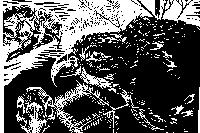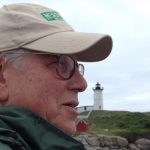 Instructor Barbara Putnam is encouraging her students to bridge the gap between art and science in her spring semester class, Drawing on Science.
Instructor Barbara Putnam is encouraging her students to bridge the gap between art and science in her spring semester class, Drawing on Science.
“It’s always been my hunch that the two disciplines go together,” Putnam said recently, speaking in the Visual Arts Center among pieces made by her students for their first show. For a short time, black-and-white sculptures and prints of birds and bird-like images filled the Center’s halls. A mobile of migrating birds would flutter slightly every time a nearby door opened.
To illustrate her case, Putnam points to the drawings by 19th-century naturalists as an example of where the two fields once more strongly overlapped. “They trusted their eyes more than they trusted the camera,” she said. And she said scientists today are developing visual means of persuasively presenting their discoveries and arguments.
This year the Boston-based artist is doing a residency on campus as Bowdoin’s Coastal Studies Scholar. Her own prints and printed quilts explore fragile transitional ecosystems and environmental issues.
As a teacher, Putnam says the best way for students to develop their perception is through practice. Besides her regular teaching job at St. Mark’s School in Southborough, Mass., Putnam has taught drawing to geology students at MIT. There, she helped a class learn observation strategies to sharpen their visual awareness as they studied and learned the differences between rocks.
To help her Bowdoin students hone their observations of their surroundings, Putnam has brought her class to the Coastal Studies Center in Harpswell, to the bird collection in Druckenmiller Hall, and to the Arctic Museum on campus. The students draw directly on wood blocks or linoleum sheets, which they then carve into prints.
While some students in the class are art majors, others come from academic backgrounds in biology, earth and oceanographic science, and chemistry, Putnam said.
The assignment that generated the student show, The Birds of Maine, The Extended Print: An Aviary, in the VAC, was to create a hanging three-dimensional object exploring the concept of flight or migration. Using their discarded prints and found objects, the students fashioned new art while considering elements such as skeletal structure, feather construction, anatomy, flight physics, orienteering, time and distance. Putnam encouraged the students to also touch on issues such as global warming, human interference with migratory flight routes, mythology, and other areas where birds and people come together, sometimes in conflict.
Putnam asks her students to not just sketch habitats and species, but also to research and read about them, such as looking into a bird’s habitat or migration route. “Say you’re reading about nutrient storage as birds get ready to migrate, then as you’re looking at a bird, you think about aspects of bird flight that wouldn’t be apparent to you if you were just drawing a still-life,” she said. She reminds her students, “We make art about the things we don’t know.”
“If something is written on my headstone, it will be, “She made them look. It’s so important in science; it’s so important in art,” Putnam said.
A second show of the students’ work from this course will be hung in the Environmental Studies common room after spring break.
